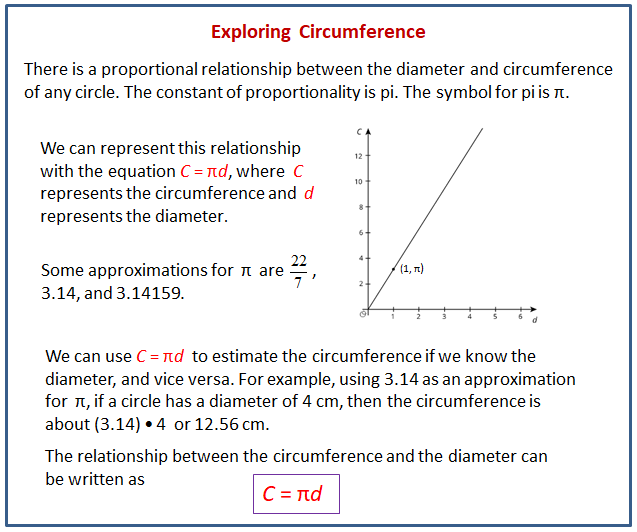Illustrative Mathematics Grade 7, Unit 3, Lesson 3: Exploring Circumference
Learning Targets:
- I can describe the relationship between circumference and diameter of any circle.
- I can explain what π means.
Related Pages
Illustrative Math
Grade 7
Lesson 3: Exploring Circumference
Let’s explore the circumference of circles.
Illustrative Math Unit 7.3, Lesson 3 (printable worksheets)
Lesson 3 Summary
The following diagram shows how to identify the diameter, center, radius, and circumference of a circle.

Lesson 3.1 Which Is Greater?
Clare wonders if the height of the toilet paper tube or the distance around the tube is greater. What information would she need in order to solve the problem? How could she find this out?
Lesson 3.2 Measuring Circumference and Diameter
Coins, cookies, and drinking glasses are some examples of common circular objects.
- Explore the applet to find the diameter and the circumference of three circular objects to the nearest tenth of a unit. Record your measurements in the table.
Open Applet - Plot the diameter and circumference values from the table on the coordinate plane. What do you notice?
Open Applet - Plot the points from two other groups on the same coordinate plane. Do you see the same pattern that you noticed earlier?
Are you ready for more?
Suppose you had another circular object with a diameter that is half as long as the diameter of your largest circle. What would its circumference be?
-
Show Answer
Since the circumference and diameter are proportional, the circumference would also be half as long.
Lesson 3.3 Calculating Circumference and Diameter
Here are five circles. One measurement for each circle is given in the table.
Use the constant of proportionality estimated in the previous activity to complete the table.
Are you ready for more?
The circumference of the Earth is approximately 40,000 km. If you made a circle of wire around the globe, that is only 10 meters (0.01 km) longer than the circumference of the globe, could a flea, a mouse, or even a person creep under it?
-
Show Answer
Since there is a slack of 10 meters, it would be more than enough for a person creep under it.
Lesson 3 Practice Problems
- Diego measured the diameter and circumference of several circular objects and recorded his measurements in the table.
One of his measurements is inaccurate. Which measurement is it? Explain how you know. - Complete the table. Use one of the approximate values for π discussed in class (for example 3.14, 22/7, 3.1416). Explain or show your reasoning.
- a. Name a segment that is a radius. How long is it?
b. Name a segment that is a diameter. How long is it? - a. Consider the equation y = 1.5x + 2. Find four pairs of x and y values that make the equation true. Plot the points (x,y) on the coordinate plane.
b. Based on the graph, can this be a proportional relationship? Why or why not?
The Open Up Resources math curriculum is free to download from the Open Up Resources website and is also available from Illustrative Mathematics.
Try out our new and fun Fraction Concoction Game.
Add and subtract fractions to make exciting fraction concoctions following a recipe. There are four levels of difficulty: Easy, medium, hard and insane. Practice the basics of fraction addition and subtraction or challenge yourself with the insane level.

We welcome your feedback, comments and questions about this site or page. Please submit your feedback or enquiries via our Feedback page.